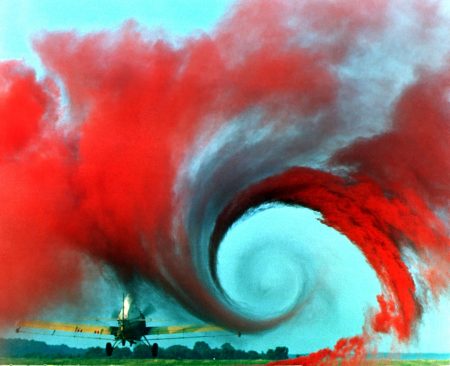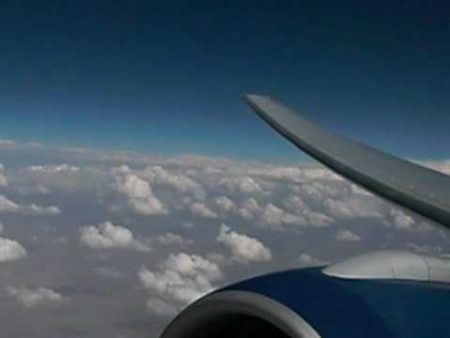April 7, 2017 – An atmosphere with more carbon dioxide (CO2) means more churn which for airlines poses a problem, increasing air turbulence. So states a paper to be published in the May 2017 issue of Advances in Atmospheric Sciences. States author of the study, Paul D. Williams, Department of Meteorology, University of Reading, “The climate is changing, not just where we live at ground level, but also where we fly at 30,000-40,000 feet.” The consequences to airlines, flight operations, route selection and crew and passenger comfort.
Where research has been looking at aviation’s contribution to greenhouse gas accumulations in the atmosphere, not very much investigation has gone into the impact of atmospheric warming on business operations. Some studies have investigated how rising sea levels may cause coastal airports to relocate or build berms and sea walls. Others have studied how the heat-island effect over airports has impacted the calculation of takeoff weights. And others have looked at lightning, snow, ice and the disruptive impacts of these natural phenomena on scheduling, flight altitudes, and lane routing. Most recently researchers have studied the changing behaviour of the Jet Stream in light of impacts of global warming at the poles, a subject I covered in a
Most recently researchers have studied the changing behaviour of the Jet Stream in light of impacts of global warming at the poles, a subject I covered in a March 29th posting here on the 21ast Century Tech blog. Another characteristic change in the Jet Stream is the strengthening of winds in the mid-latitudes of both the Northern and Southern Hemispheres. Here tropospheric and stratospheric warming and cooling are causing unprecedented thermodynamic effects on winds. This not only is leading to more extreme weather events as seen in thunderstorms and hurricanes, but also in “clear-air turbulence.”
What is clear-air turbulence?
It is the movement of air masses in a turbulent manner in the absence of clouds or other weather phenomena. In the past clear-air turbulence has been most associated with airplanes passing through the Jet Stream. And anthropogenic climate change is seen as an enabler of the phenomenon. Climate models indicate increasing moderate or greater turbulence on Trans-Atlantic flights, particularly in the Northern Hemisphere’s winter season. The numbers at the low end are 40% with a high end of 170%. The current median length of time in which clear-air turbulence is experienced amounts to 5 minutes or 60 kilometers (37 miles) in distance traveled. And the median thickness of clean-air turbulence is about 1 kilometer (0.6 miles) in vertical height.
There are 790 turbulence encounters reported by United States air carriers annually today. These result in over 680 minor injuries and 38 serious ones to flight attendants, and 120 minor injuries and 17 serious ones to passengers. Unreported clear air turbulence injuries are thought to be much higher considering records show 63,000 moderate or greater turbulence, and 5,000 severe or greater episodes annually. Incidents of damage to aircraft plus injuries to passengers and crew today cost American carriers almost $200 million per year. When you consider that global air traffic has been growing at a rate of 5% per year, and expected to continue at that pace for at least two more decades, increased turbulence becomes not just a safety problem but also an economic one.
In the current study which focuses on air traffic across the North Atlantic, the modeling indicates with doubled levels of atmospheric CO2 from pre-Industrial times, the following results:
- a 59% increase in light turbulence episodes.
- a 75% increase in light to moderate episodes.
- a 127% increase in moderate to severe episodes.
- and a 149% increase in severe episodes.
No one is suggesting that CO2 will double to 500 ppm in this century, which is approximately a doubling from the pre-Industrial period in human history. But we are already at near 410 and climbing. Without dramatic cuts in carbon emissions, the concentration of CO2 is likely to hit 450 by mid-century. That’s not far off from the 500 ppm model which produced the extreme results described above.
One would also expect that the duration of clear-air turbulence and the thickness of the air column in which the turbulence occurs will also be impacted.
So how is the industry preparing itself for increasing turbulence?
On-board detection of clear-air turbulence technology may become standard equipment on all aircraft. Forward-looking LIDAR (Light Detection and Ranging ultraviolet laser) will be able to warn pilots of changes in air density indicative of clear-air turbulence up to 10 to 15 (6 to 9 miles) before it is encountered. This may allow pilots a little more than a minute at cruising speeds to alter course or advise passengers and attendants of the phenomena. The economic cost of retrofitting airline fleets to have on-board LIDAR will make flying more expensive.
The unknowns of how increasing incidents of clear-air turbulence may affect the normal atmospheric exchange between troposphere and stratosphere, the formation of clouds, frequency of thunderstorms and other extreme weather, and larger atmospheric circulation, have yet to be explored. And because this new study is specific to looking at winter seasonal air turbulence on Trans-Atlantic routes, the authors suggest that other seasons and other geographic areas need to be examined similarly.











